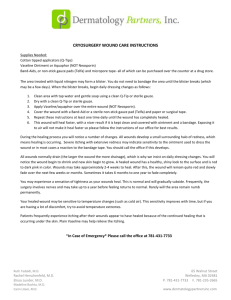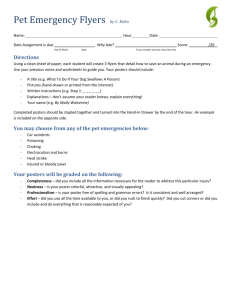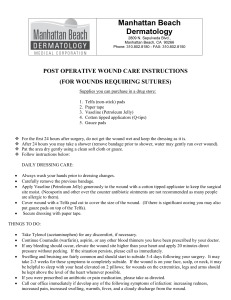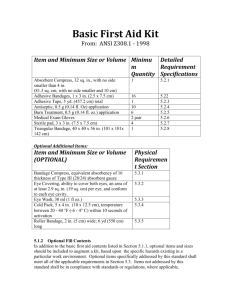Quiz
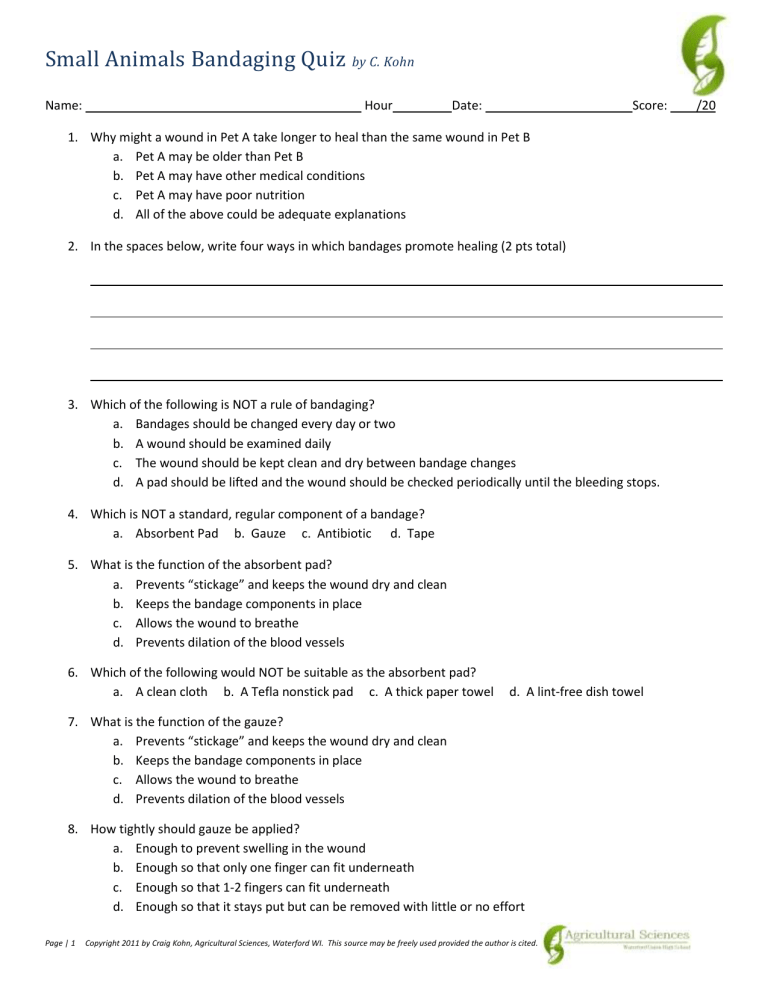
Small Animals Bandaging Quiz
by C. Kohn
Name: Hour Date: Score: /20
1.
Why might a wound in Pet A take longer to heal than the same wound in Pet B a.
Pet A may be older than Pet B b.
Pet A may have other medical conditions c.
Pet A may have poor nutrition d.
All of the above could be adequate explanations
2.
In the spaces below, write four ways in which bandages promote healing (2 pts total)
3.
Which of the following is NOT a rule of bandaging? a.
Bandages should be changed every day or two b.
A wound should be examined daily c.
The wound should be kept clean and dry between bandage changes d.
A pad should be lifted and the wound should be checked periodically until the bleeding stops.
4.
Which is NOT a standard, regular component of a bandage? a.
Absorbent Pad b. Gauze c. Antibiotic d. Tape
5.
What is the function of the absorbent pad? a.
Prevents “stickage” and keeps the wound dry and clean b.
Keeps the bandage components in place c.
Allows the wound to breathe d.
Prevents dilation of the blood vessels
6.
Which of the following would NOT be suitable as the absorbent pad? a.
A clean cloth b. A Tefla nonstick pad c. A thick paper towel d. A lint-free dish towel
7.
What is the function of the gauze? a.
Prevents “stickage” and keeps the wound dry and clean b.
Keeps the bandage components in place c.
Allows the wound to breathe d.
Prevents dilation of the blood vessels
8.
How tightly should gauze be applied? a.
Enough to prevent swelling in the wound b.
Enough so that only one finger can fit underneath c.
Enough so that 1-2 fingers can fit underneath d.
Enough so that it stays put but can be removed with little or no effort
Page | 1 Copyright 2011 by Craig Kohn, Agricultural Sciences, Waterford WI. This source may be freely used provided the author is cited.
9.
What is the function of the tape? a.
Prevents “stickage” and keeps the wound dry and clean b.
Keeps the bandage components in place c.
Allows the wound to breathe d.
Prevents dilation of the blood vessels
10.
If you are trying to control bleeding and the absorbent pad becomes soaked, what should you do? a.
Remove the pad and replace it with a clean pad b.
Continue to hold the soaked pad in place and allow the blood to drip c.
Cover the first pad with a second unused pad d.
Remove the first pad and examine the wound for additional injury
11.
If a pet has long hair, should it be clipped prior to applying a bandage? a.
Yes – wherever a bandage will be applied, the hair should be removed b.
Yes – the hair should be shaved to the skin immediately around the wound c.
Yes – the hair should be clipped short within one inch of the wound d.
No – the hair will help prevent infection
12.
Which of the following would be acceptable for flushing a wound free of debris? a.
Saline solution b.
Weak iodine solution c.
Clean water d.
All of the above would be acceptable
13.
An antiseptic is… a.
A substance that inhibits the growth and reproduction of bacteria, such as iodine b.
Another name for antibiotics c.
A substance that should be avoided when applying a bandage d.
All of the above
14.
When applying gauze, how many times should the gauze wrap around the wound? a.
1 time b.
1-2 times c.
2-3 times d.
5+ times
15.
In the space below, describe how you would respond if you found your dog or cat with a severe injury that required cleaning and a bandage. Be sure to list and describe all steps necessary to stop the bleeding, prevent infection, and allow the wound to heal (5 pts).
Page | 2 Copyright 2011 by Craig Kohn, Agricultural Sciences, Waterford WI. This source may be freely used provided the author is cited.


